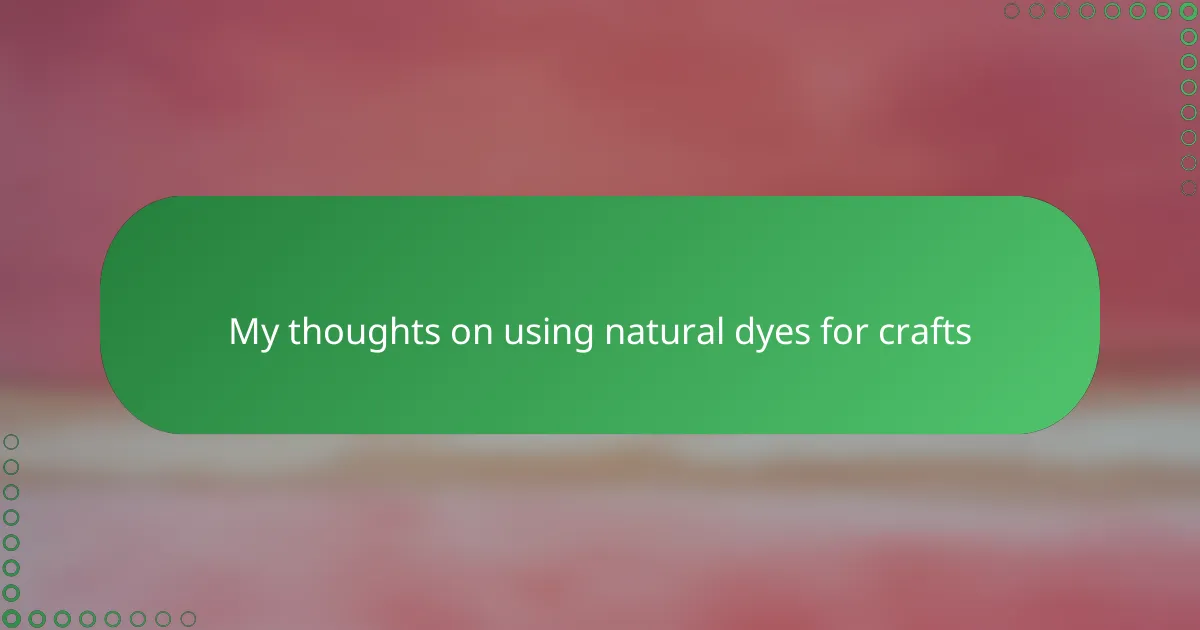Key takeaways
- Natural dyes are sourced from plants, minerals, and insects, providing unique, rich colors that connect crafts to the environment.
- Using natural dyes encourages patience and mindfulness in the crafting process, enhancing appreciation for individual creations.
- Variety in dye sources, such as turmeric and beetroot, offers numerous possibilities for color and texture in handmade paper crafts.
- Testing colors and maintaining an organized workspace can improve the dyeing process, leading to more successful and enjoyable projects.
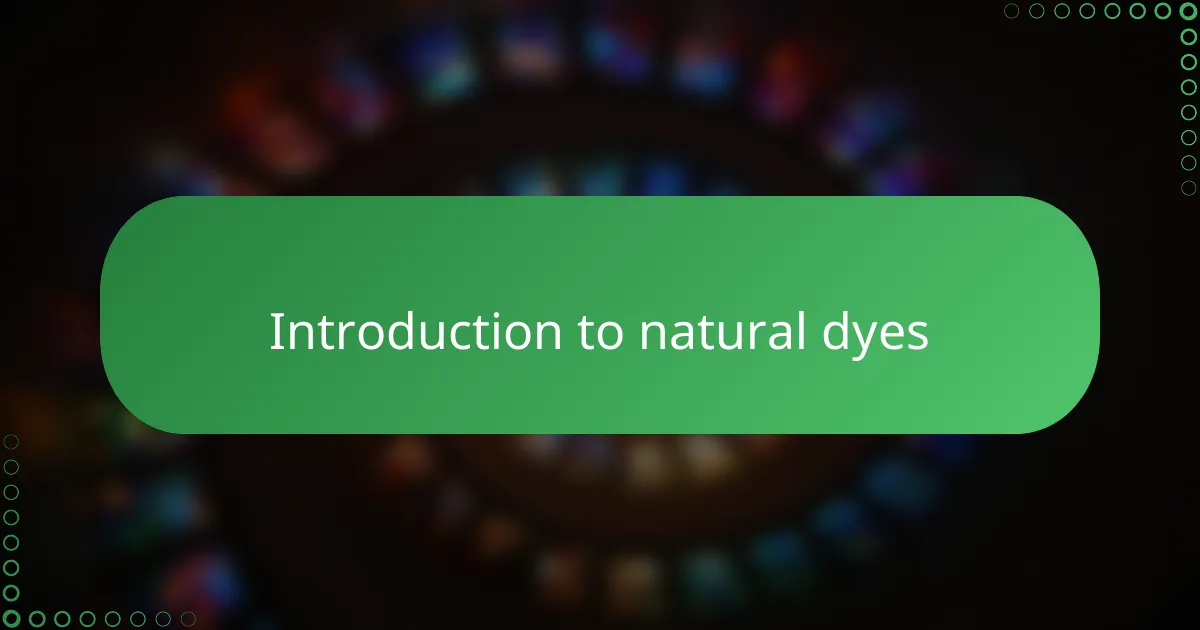
Introduction to natural dyes
Natural dyes have always fascinated me with their ability to transform ordinary materials into vibrant, living colors. Unlike synthetic dyes, they come from plants, minerals, and even insects, making each shade feel more connected to the earth. Have you ever wondered what it’s like to capture the essence of nature in a single brushstroke?
What I find most captivating is how these dyes carry stories—lavender from my garden, turmeric from the spice rack—each bringing warmth and life to handmade paper crafts. The organic imperfections and subtle hues remind me that beauty doesn’t have to be perfect to be powerful. Using natural dyes feels like a quiet conversation with history and the environment.
Exploring natural dyes opens up endless creative possibilities, but it also invites patience and respect for the materials. Unlike quick chemical processes, natural dyeing is more of a gentle ritual, rewarding those willing to embrace its unpredictability. Have you tried it yet? The experience might surprise you in the most delightful ways.
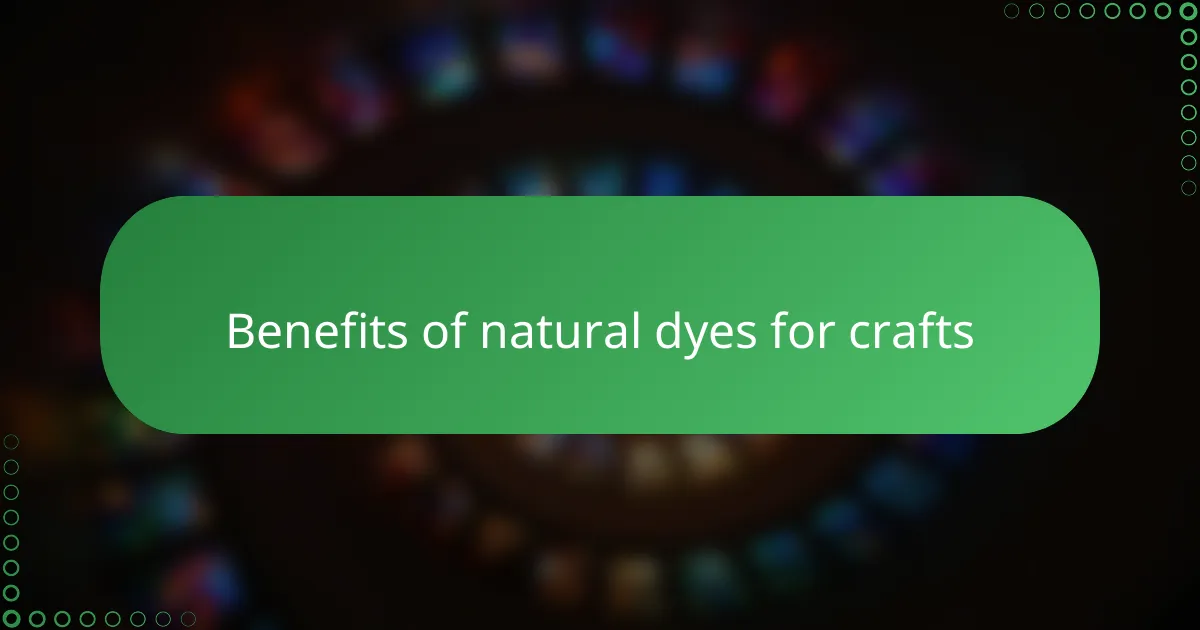
Benefits of natural dyes for crafts
One of the biggest benefits I’ve discovered with natural dyes is their gentle impact on both the environment and my workspace. Unlike harsh chemicals, these dyes come from things I can find in my kitchen or garden, which makes me feel good about what I’m pouring onto my handmade paper. Have you noticed how less toxic materials just make the creative process feel cleaner and more mindful?
I also appreciate how natural dyes bring a depth and warmth to my crafts that synthetic colors often miss. There’s something about the way turmeric or beetroot tones shift with light that synthetic dyes just can’t replicate. It reminds me of the unpredictable beauty of nature—no two pieces ever turn out exactly the same, and that uniqueness feels like a celebration.
Another surprising advantage is how natural dyes encourage me to slow down and be patient. Unlike the instant results from store-bought dyes, each batch requires attention and care, which turns crafting into a more meditative experience. Have you ever noticed how this slower pace actually makes you appreciate your work even more? I certainly have.
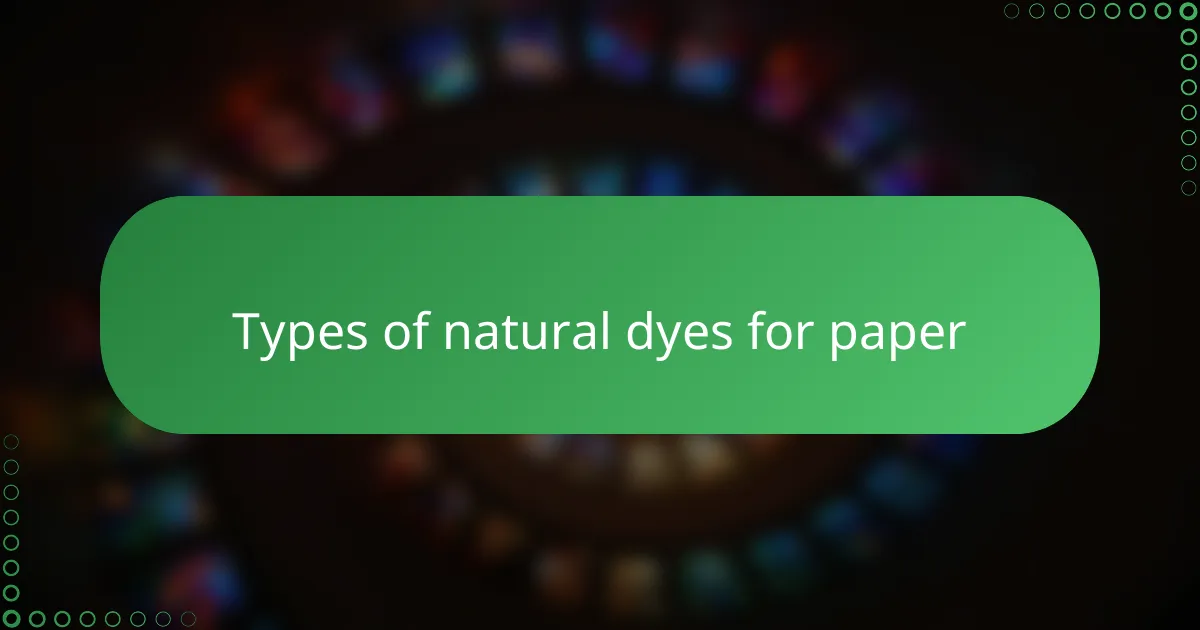
Types of natural dyes for paper
When I first started experimenting with natural dyes for paper, I was amazed by the variety nature offers. Indigo, with its deep blues, feels almost magical, while beetroot gives that lovely earthy pink that instantly warms my pages. Have you ever marveled at how just a handful of leaves or roots can set your paper alive with color?
I’ve often turned to turmeric when I want a sunny yellow that brightens my work. It’s incredible how this common kitchen spice doubles as a dye, connecting my crafts to everyday life. Sometimes, the simplest ingredients yield the richest results, and that surprise always fuels my creativity.
Then there are less obvious sources like walnut shells, which give rich browns that feel grounding and comforting. Using these natural dyes makes me think about seasons and cycles—the way colors change with the earth itself. Isn’t it fascinating how each dye not only colors the paper but also tells a story?
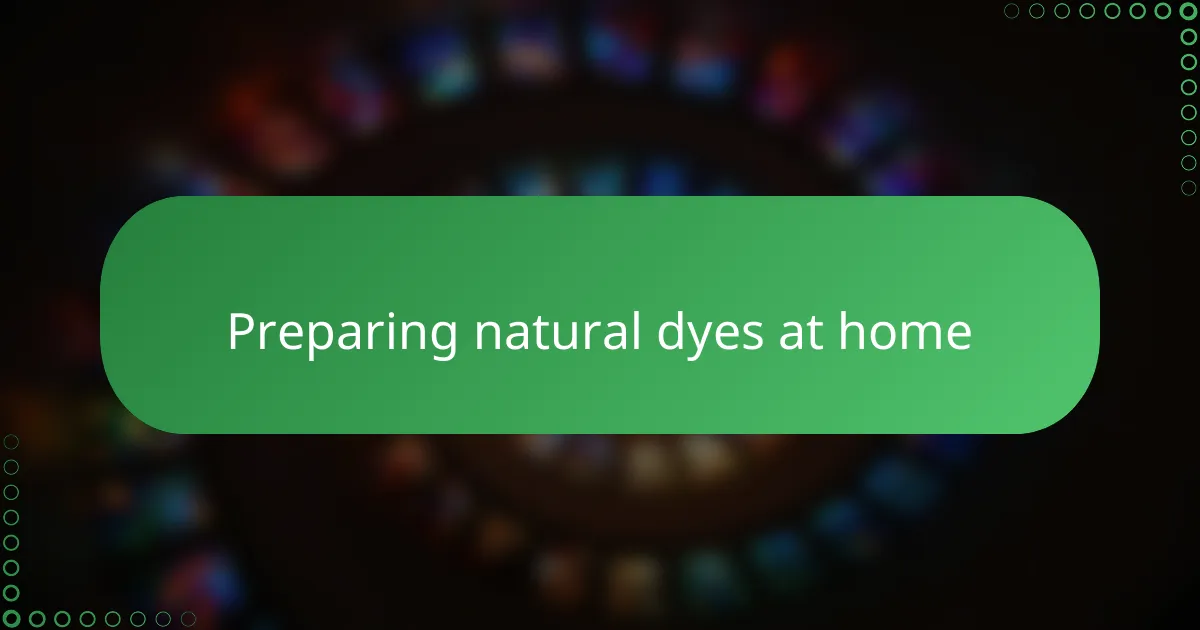
Preparing natural dyes at home
Preparing natural dyes at home feels like embarking on a small, meaningful adventure. I usually start by simmering plant materials—like onion skins or hibiscus petals—in water for about an hour, watching as the colors slowly seep out. Have you ever stood by the stove, mesmerized as ordinary leaves transform the water into liquid gold or crimson? That moment always feels like magic to me.
I like to strain the dye carefully, knowing that this simple step holds the key to smooth, vibrant colors for my paper. Sometimes, I add a bit of vinegar or salt to help set the colors, but mostly I let nature do its work without rushing. This slower pace reminds me how crafting with natural dyes is as much about patience as it is about creativity.
One time, I experimented with soaking dried flowers overnight and was amazed at the softness of the resulting hues. It made me realize that every dye source has its own personality and demands a little respect to reveal its best colors. Have you tried experimenting with different soaking times or plant materials? It’s these small discoveries that make dyeing at home so rewarding.
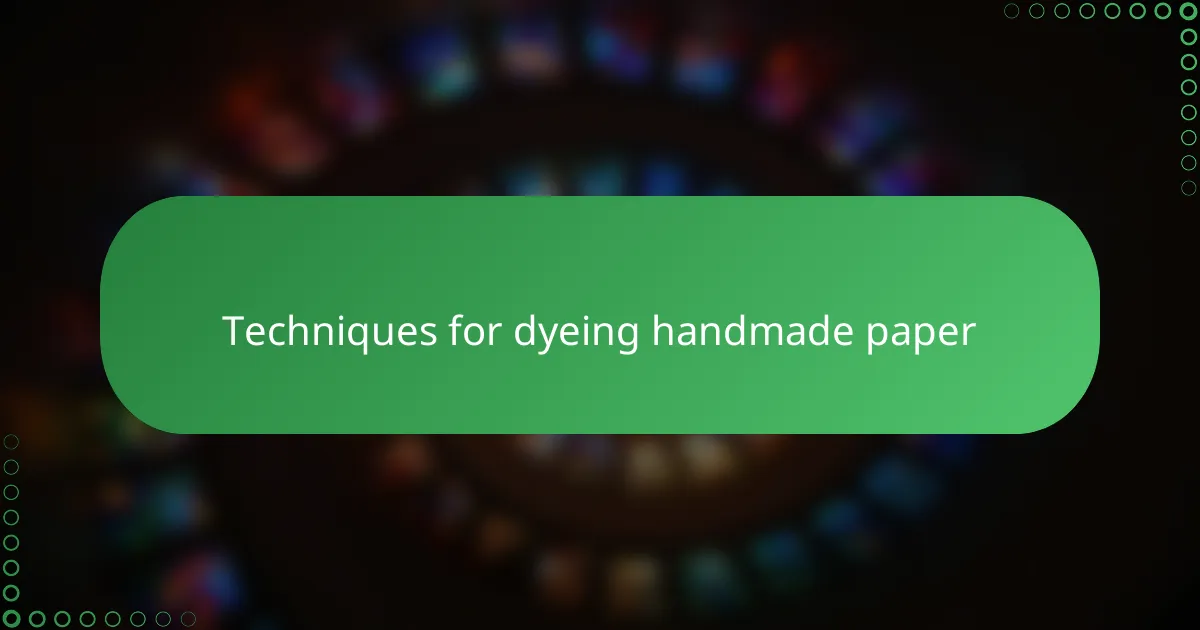
Techniques for dyeing handmade paper
Dyeing handmade paper with natural colors is a delicate dance between technique and intuition. I often start by soaking the sheet directly in the dye bath, allowing the fibers to absorb the colors evenly. Have you ever noticed how the paper drinks up the liquid, changing from blank to vibrant right before your eyes? It’s a simple step, but watching that transformation always feels like a small miracle to me.
Sometimes, I like to experiment with painting or brushing the dye onto the paper for more control over where the colors go. This technique lets me add layers and gradients, almost like creating a natural watercolor painting. I find that this approach turns the paper itself into a canvas, inviting creativity that feels both spontaneous and intentional.
Another method I’ve tried is sprinkling powdered dye powders or crushed plant matter onto wet paper. The unpredictability of how the colors spread and blend fascinates me. Have you ever embraced that happy accident, where the dye bleeds in unexpected ways? Those moments remind me why working with natural dyes is as much about letting go as it is about making something beautiful.
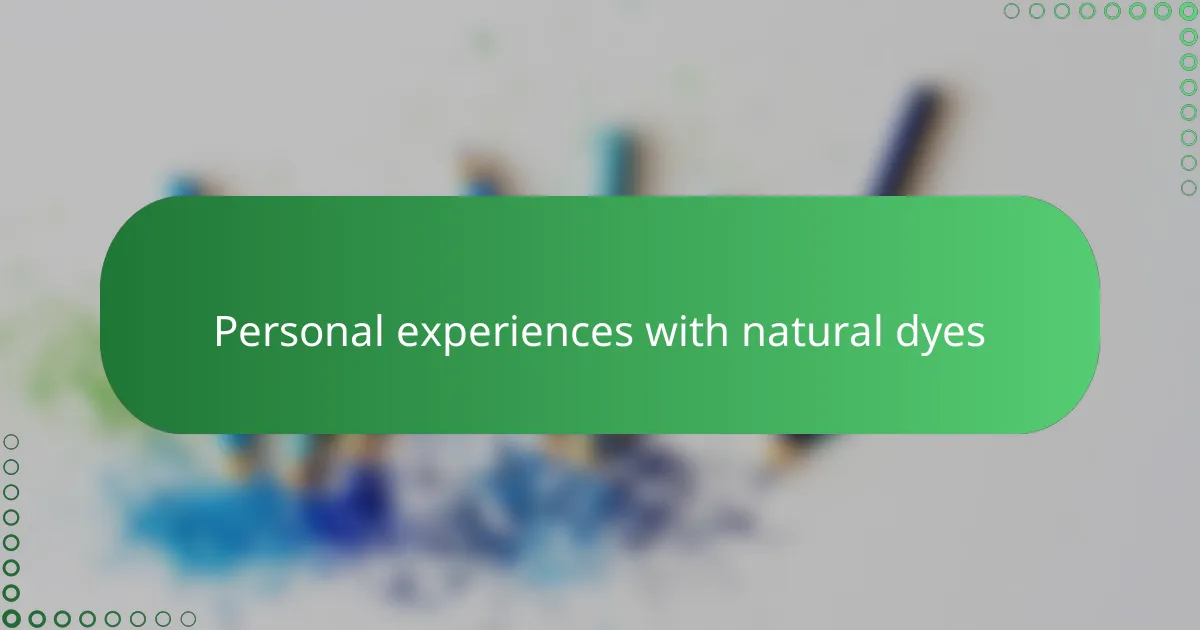
Personal experiences with natural dyes
I still remember the first time I used onion skins to dye a batch of handmade paper—it was messy, slow, and utterly rewarding. Watching the soft amber tones emerge felt like uncovering a hidden treasure right from my kitchen scraps. Have you ever felt that quiet thrill when a simple natural ingredient surprises you with such rich color?
Sometimes, the unpredictability of natural dyes challenges me, especially when the hues don’t turn out as expected. But over time, I’ve learned to embrace these quirks as part of the process, like friendly reminders that nature doesn’t always follow our plans. Don’t you think that’s where the real charm lies—in those gentle imperfections that give each piece its own story?
One particular project stands out: I used hibiscus petals for a deep pink wash and, to my delight, each sheet had subtle variations that no synthetic dye could replicate. That experience taught me that patience and attention to detail aren’t just practical—they’re the heart of working with natural dyes. Have you discovered that slowing down in your craft brings a deeper connection to what you create?
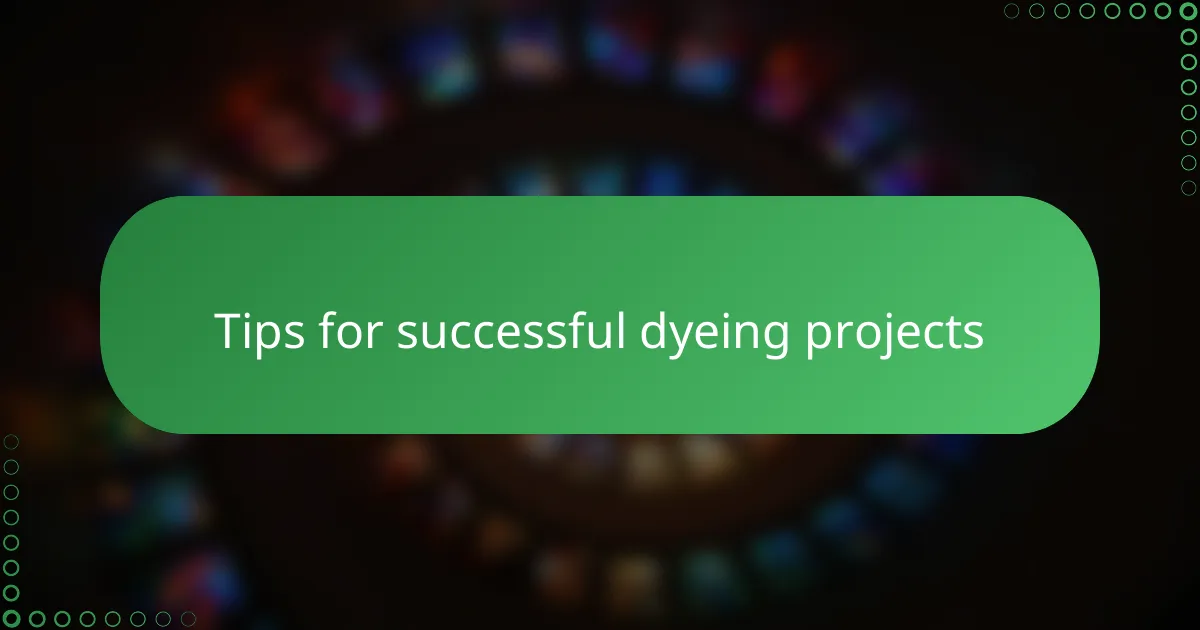
Tips for successful dyeing projects
One tip I always follow is to prepare a test strip before committing to dyeing an entire batch of paper. This little experiment helps me anticipate how the color might develop and saves me from surprises later. Have you ever been caught off guard by a dye that looks perfect in the pot but fades on paper? Testing feels like a small safety net that makes the whole process smoother.
I’ve found that temperature and timing are surprisingly crucial. A gentle simmer often brings out richer hues without breaking down delicate fibers, and I tend to keep an eye on the clock so the color doesn’t become dull from overexposure. From my experience, dyeing is a balancing act—too little time means weak colors, too much can wash them out. Isn’t that patience part of the craft’s charm?
Finally, I try to keep my workspace organized, with all materials within reach and dye baths covered when not in use. It might sound straightforward, but this little habit has saved me so many frustrating spills and ruined projects. Have you noticed how a calm, tidy setup makes the creative flow feel more joyful? For me, a peaceful environment is just as important as the dyes themselves.
